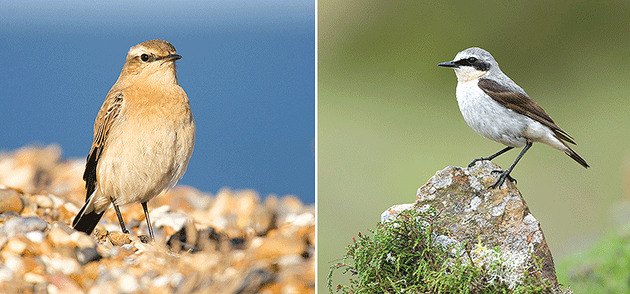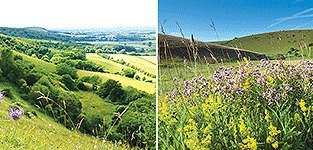March Sussex Wildlife Trust: The Wheatear
March 1st, 2024
It’s been a long winter, but rest assured that our summer migrant birds will soon be with us. As you read this, beating hearts and beating wings are powering tiny bodies through north African skies.
Wheatears are our earliest returning African migrants. It’s a fast 3,000-mile flight from sub-Saharan Sierra Leone to Sussex for a 1-ounce Wheatear, and they’ve been recorded migrating at 500 miles a day. The dashing males arrive first, their soft, sun-bleached shades of pink and buff topped with a dapper black bandit’s mask.
At Sussex Wildlife Trust’s Southerham nature reserve near Lewes, you’ll see them scurrying over the grazed downland turf or perched along the valley’s fence lines. When they fly, Wheatears flash the white rump which gives them their name. Because Wheatears have nothing to do with wheat or ears.
Their original name...well, courtesy prevents me from writing their old English name in such an upstanding publication – but let’s just say they were named after their white behinds. Victorians and vicars bird watching in mixed company blushed when they were called upon to identify one, so their name was subtly censored.
Wheatear is a more palatable name for a tragically palatable bird. In Sussex, Wheatears were considered a local delicacy and were served at the finest banquets in Lewes, Brighton and Eastbourne. Sussex shepherds would trap them to increase their income; in the late 19th Century the birds fetched 3/6d a dozen (£17.50 today). Shepherds could earn £14 per season (£1,260 today) trapping Wheatears - half their annual wage. Around the town, shepherds were eventually banned from trapping Wheatears as it distracted them from their sheep.
Gluttonous gourmets were so desperate for fresh Wheatear that they would prowl the downs and take birds straight from unmanned traps, leaving a pile of coins for the shepherds.
In 1900, outspoken and outraged Sussex conservationist W.H Hudson wrote, 'It is not fair that Wheatears should be killed merely to enable London stockbrokers, sporting men, and other gorgeous persons who visit the coast, accompanied by ladies with yellow hair, to feed on them at the big Brighton hotels.'
But the damage was done. Trapping and the gradual loss of their sheep-grazed downland habitat caused the birds to disappear from the Sussex downs. The Wheatears we now see around Lewes unsurprisingly don’t hang around. Each spring they briefly return to their old downland haunts, flash their behinds at the people of Sussex and keep on moving.
From Lewes, they’ll head onwards to breeding sites in northern England and northern Europe. But for some of these birds, their amazing migration continues for a further 2,000 miles across cold oceans to Greenland and Arctic Canada.
By Michael Blencowe: Learning & Engagement Officer, Sussex Wildlife Trust.
Sussex Wildlife Trust is an independent registered charity caring for wildlife and habitats throughout Sussex. It’s easy to join online at: www.sussexwildlifetrust.org.uk/join
or T: 01273 497532
Wheatears are our earliest returning African migrants. It’s a fast 3,000-mile flight from sub-Saharan Sierra Leone to Sussex for a 1-ounce Wheatear, and they’ve been recorded migrating at 500 miles a day. The dashing males arrive first, their soft, sun-bleached shades of pink and buff topped with a dapper black bandit’s mask.
At Sussex Wildlife Trust’s Southerham nature reserve near Lewes, you’ll see them scurrying over the grazed downland turf or perched along the valley’s fence lines. When they fly, Wheatears flash the white rump which gives them their name. Because Wheatears have nothing to do with wheat or ears.
Their original name...well, courtesy prevents me from writing their old English name in such an upstanding publication – but let’s just say they were named after their white behinds. Victorians and vicars bird watching in mixed company blushed when they were called upon to identify one, so their name was subtly censored.
Wheatear is a more palatable name for a tragically palatable bird. In Sussex, Wheatears were considered a local delicacy and were served at the finest banquets in Lewes, Brighton and Eastbourne. Sussex shepherds would trap them to increase their income; in the late 19th Century the birds fetched 3/6d a dozen (£17.50 today). Shepherds could earn £14 per season (£1,260 today) trapping Wheatears - half their annual wage. Around the town, shepherds were eventually banned from trapping Wheatears as it distracted them from their sheep.
Gluttonous gourmets were so desperate for fresh Wheatear that they would prowl the downs and take birds straight from unmanned traps, leaving a pile of coins for the shepherds.
In 1900, outspoken and outraged Sussex conservationist W.H Hudson wrote, 'It is not fair that Wheatears should be killed merely to enable London stockbrokers, sporting men, and other gorgeous persons who visit the coast, accompanied by ladies with yellow hair, to feed on them at the big Brighton hotels.'
But the damage was done. Trapping and the gradual loss of their sheep-grazed downland habitat caused the birds to disappear from the Sussex downs. The Wheatears we now see around Lewes unsurprisingly don’t hang around. Each spring they briefly return to their old downland haunts, flash their behinds at the people of Sussex and keep on moving.
From Lewes, they’ll head onwards to breeding sites in northern England and northern Europe. But for some of these birds, their amazing migration continues for a further 2,000 miles across cold oceans to Greenland and Arctic Canada.
By Michael Blencowe: Learning & Engagement Officer, Sussex Wildlife Trust.
Sussex Wildlife Trust is an independent registered charity caring for wildlife and habitats throughout Sussex. It’s easy to join online at: www.sussexwildlifetrust.org.uk/join
or T: 01273 497532
Wheatear Marshall Sussex Wildlife Trust
Wheatear Derek Middleton Sussex Wildlife TrustComments (0)
No comments have been submitted yet.Why not be the first to send us your thoughts
Leave A Comment
Thank you for your comments, they will appear shortly once approved.
Recent Posts
Have You Seen...






